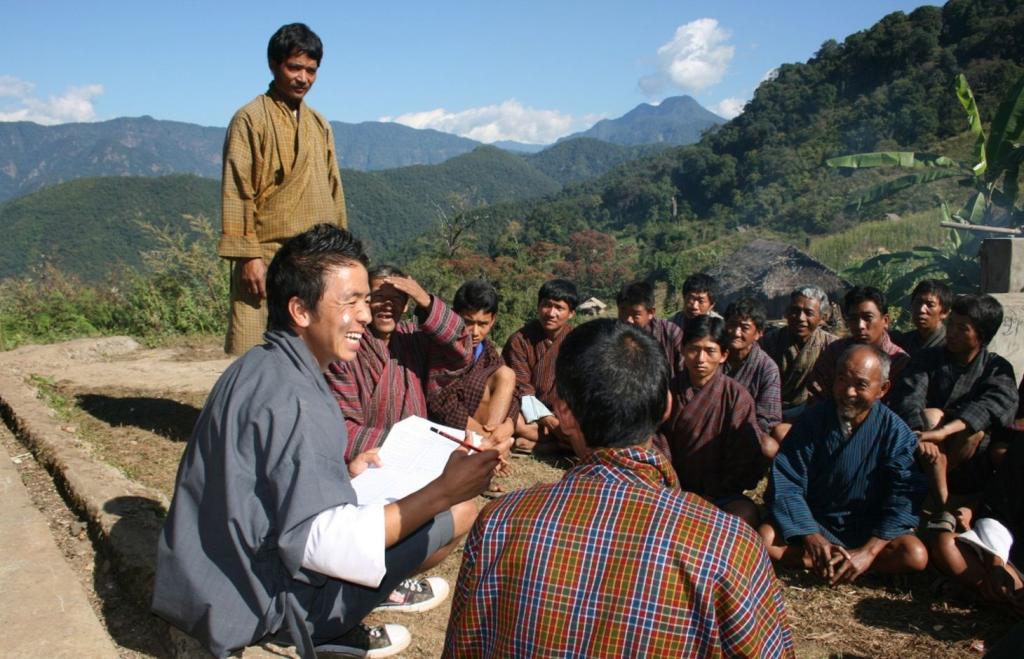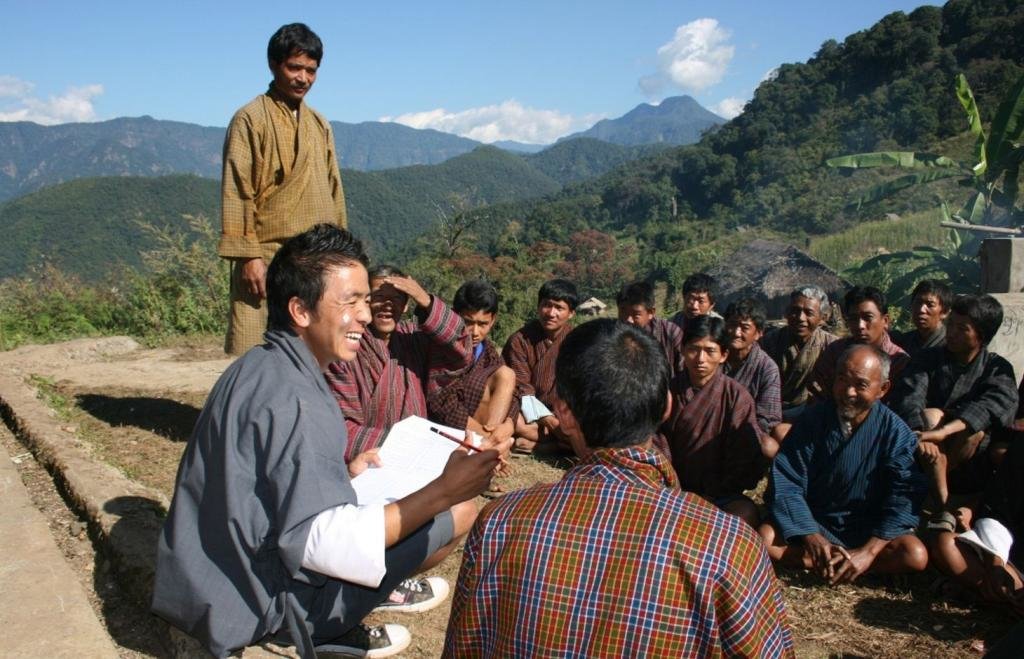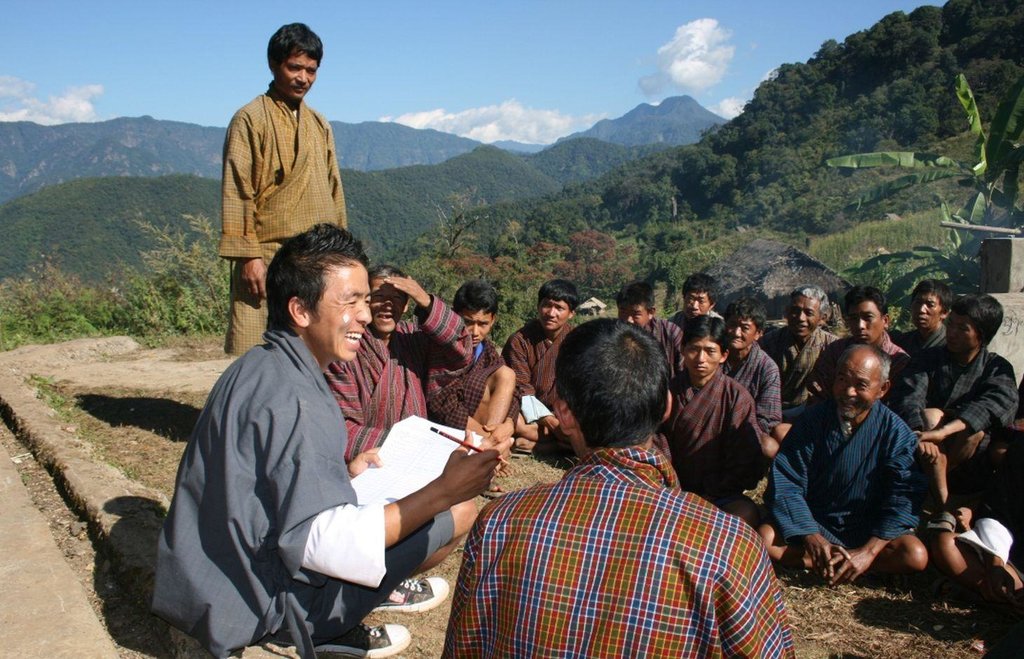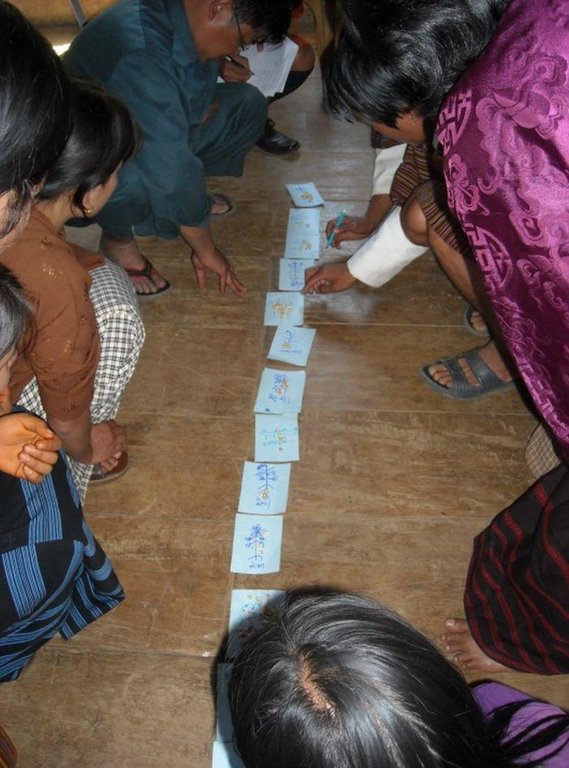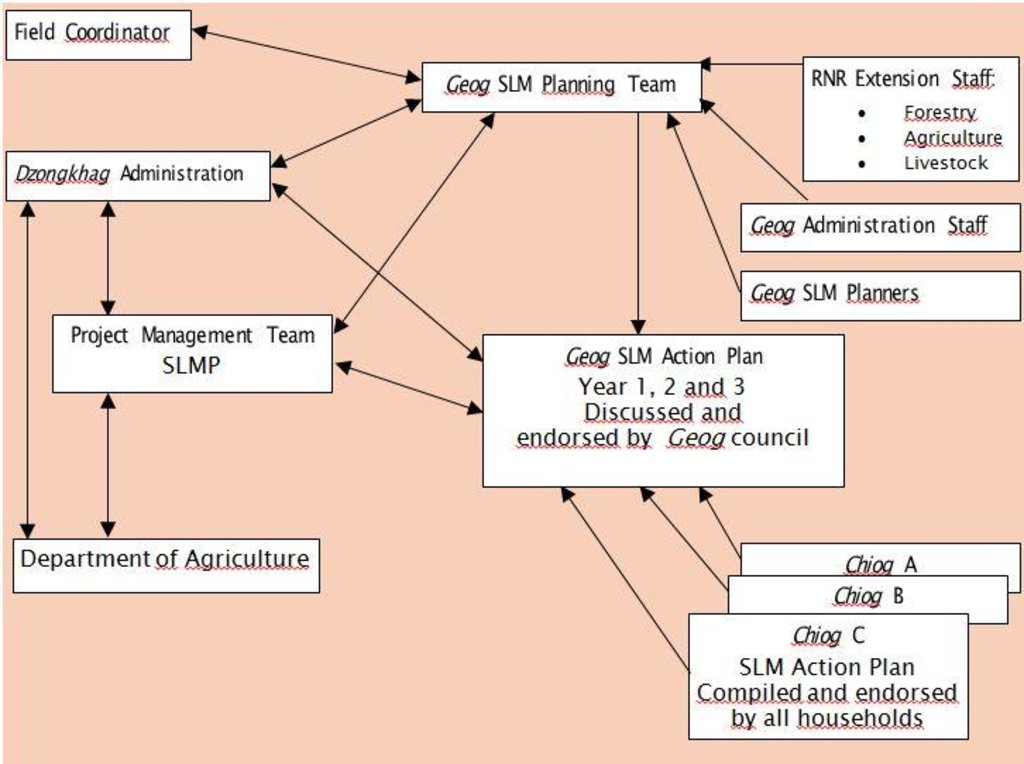Participatory SLM Action Planning [ប្រទេសប៊ូតង់]
- ការបង្កើត៖
- បច្ចុប្បន្នភាព
- អ្នកចងក្រង៖ Karma Dorji
- អ្នកកែសម្រួល៖ –
- អ្នកត្រួតពិនិត្យ Fabian Ottiger
approaches_2489 - ប្រទេសប៊ូតង់
ពិនិត្យមើលគ្រប់ផ្នែក
ពង្រីកមើលទាំងអស់ បង្រួមទាំងអស់1. ព័ត៌មានទូទៅ
1.2 ព័ត៌មានលម្អិតពីបុគ្គលសំខាន់ៗ និងស្ថាប័នដែលចូលរួមក្នុងការវាយតម្លៃ និងចងក្រងឯកសារនៃវិធីសាស្ត្រផ្សព្វផ្សាយ
អ្នកជំនាញឯកទេស SLM:
Wangdi Tashi
NSSC, DoA, MoAF, RGoB
ប្រទេសប៊ូតង់
អ្នកជំនាញឯកទេស SLM:
Dorji Tshering
NSSC, DoA, MoAF, RGoB
ប្រទេសប៊ូតង់
ឈ្មោះអង្គភាពមួយ (ច្រើន) ដែលបានចងក្រងឯកសារ/ វាយតម្លៃលើវិធីសាស្ត្រផ្សព្វផ្សាយ (បើទាក់ទង)
National Soil Services Centre (National Soil Services Centre) - ប្រទេសប៊ូតង់ឈ្មោះអង្គភាពមួយ (ច្រើន) ដែលបានចងក្រងឯកសារ/ វាយតម្លៃលើវិធីសាស្ត្រផ្សព្វផ្សាយ (បើទាក់ទង)
MoA (MoA) - ប្រទេសប៊ូតង់1.3 លក្ខខណ្ឌទាក់ទងទៅនឹងការប្រើប្រាស់ទិន្នន័យដែលបានចងក្រងតាមរយៈវ៉ូខេត
តើពេលណាដែលទិន្នន័យបានចងក្រង (នៅទីវាល)?
14/03/2011
អ្នកចងក្រង និង(បុគ្គលសំខាន់ៗ)យល់ព្រមទទួលយកនូវលក្ខខណ្ឌនានាទាក់ទងទៅនឹងការប្រើប្រាស់ទិន្នន័យដែលបានចងក្រងតាមរយៈ វ៉ូខេត:
បាទ/ចា៎
2. ការពណ៌នាអំពីវិធីសាស្ត្រផ្សព្វផ្សាយ SLM
2.1 ពណ៌នាសង្ខេបខ្លីពីវិធីសាស្ត្រផ្សព្វផ្សាយ
A methodology to identify in a participatory manner at village level land-based problems, its causal factors and mitigation measures to reduce land degradation and enhance rural livelihoods
2.2 ពណ៌នាលម្អិតពិវិធីសាស្ត្រផ្សព្វផ្សាយ
ពណ៌នាលម្អិតពិវិធីសាស្ត្រផ្សព្វផ្សាយ:
Aims / objectives: Participatory SLM Action Planning (SLM AP) is a methodology that aims at prioritiz-ing possible SLM interventions to mitigate the most critical land degradation issues. Priorities are based on the identification of land-based livelihoods and livelihood resources, the key area-based problems and their causes. SLM AP is carried out in the SLMP geogs (block) at chiog (village) level, including all community households. It involves elements of PRA/PLA such as problem census, cropping calendars, history lines, natural resource mapping and builds on the in-depth knowledge and understanding of farming households of their land, their problems and opportunities. The process is highly visual to include the illiterate and very interactive by giving the communities the lead in prioritizing their problems and deciding on SLM interventions.
Methods: The SLM AP is an iterative process, starting with building and training SLM planning teams (GSPTs) at geog level, comprising of extension staff and locally recruited geog SLM planners (GSPs) and geog administration staff. The GSPTs start awareness and mobilization activities in the first year at geog council level. This is followed by a 3 day SLM AP in each and every chiog of the geog to compile a chiog SLM action plan. The village SLM APs are combined into a geog SLM AP and discussed, amended and endorsed in a public meeting by the geog council. The necessary budget is allocated by SLMP project and implementation of the planned activities takes place at chiog level.
Stages of implementation: Implementation is preceded by intensive training and capacity building of the communities in SLM activities. In the second year a new SLM AP round is made, lasting only one day, with review of the previous SLM AP at chiog level. Potential new activities are identified, based on field experiences, to complete the new SLM AP for year 2. In the final year 3, a last SLM AP round is made in all chiogs to compile chiog and ultimately a geog SLM AP.
Role of stakeholders: SLM AP is an inclusive process and gender sensitive, with focus on vulnerable households. The approach includes participatory Natural Resource mapping at chiog level and participatory Monitoring & Evaluation to track implementation progress and impact and to get feedback of the communities.
Other important information: Environmental and social screening procedures are applied to exclude any negative impact on the land or on social groups. SLM AP was piloted in 3 geogs in 3 Dzongkhags since 2006 and has been rolled out to more than 130 chiogs in 9 geogs.
2.3 រូបភាពនៃវិធីសាស្ត្រផ្សព្វផ្សាយ
2.5 ប្រទេស/តំបន់/ទីតាំងកន្លែង ដែលវិធីសាស្ត្រផ្សព្វផ្សាយត្រូវបានអនុវត្តន៍
ប្រទេស:
ប្រទេសប៊ូតង់
តំបន់/រដ្ឋ/ខេត្ត:
Chhukha, Trashigang and Zhemgang Dzongkhags
បញ្ជាក់បន្ថែមពីលក្ខណៈនៃទីតាំង:
9 separate geogs
2.6 កាលបរិច្ឆេទនៃការចាប់ផ្តើម និងបញ្ចប់នៃវិធីសាស្រ្តផ្សព្វផ្សាយនេះ
សូមបញ្ជាក់ឆ្នាំដែលបានបង្កើតឡើង:
2006
ឆ្នាំបញ្ចប់ (ប្រសិនបើវិធីសាស្ត្រផ្សព្វផ្សាយត្រូវបានឈប់ប្រើប្រាស់):
2012
2.7 ប្រភេទនៃវិធីសាស្ត្រផ្សព្វផ្សាយ
- ផ្អែកលើគម្រោង/កម្មវិធី
2.8 គោលបំណង/ទិសដៅសំខាន់នៃវិធីសាស្ត្រផ្សព្វផ្សាយ
The Approach focused mainly on SLM with other activities (livelihoods, cash income, food security, capacity building, awareness raising)
- To build community capacity to assess land degradation and identify and prioritize mitigation measures
- Enhancement of rural livelihoods
The SLM Approach addressed the following problems: - Lack of awareness of land degradation processes, combined with limited technical knowledge to tackle its causes.
- Planning procedures are top-down and do not incorporate land-based issues adequately and fail to build local ownership and sustainability.
2.9 លក្ខខណ្ឌអនុញ្ញាត ឬរារាំងការអនុវត្តន៍បច្ចេកទេសដែលស្ថិតនៅក្រោមវិធីសាស្រ្តផ្សព្វផ្សាយ
ភាពអាចរកបាននៃធនធានហិរញ្ញវត្ថុ និងសេវាកម្ម
- រារាំង
Large amount of cash to handle at municipality level
Treatment through the SLM Approach: Training, monitoring and limitation of cash amounts
បរិបទនៃស្ថាប័ន
- រារាំង
Delays in financial releases to decentralised level because of lengthy/complicated administrative chain
Treatment through the SLM Approach: Training of key financial staff to shorten procedure and minimize frequency of budget releases
ក្របខណ្ឌច្បាប់ (សិទ្ធិកាន់កាប់ដីធ្លី កម្មសិទ្ធីប្រើប្រាស់ដីនិងទឹក)
- អំណោយផល
The existing land ownership, land use rights / water rights helped a little the approach implementation: Individual land titles of households favour greatly the planning and implementation of SLM activities
- រារាំង
Lack of efforts in implementing SLM technologies on land without ownership and living as tenants
Treatment through the SLM Approach: Awareness on the importance of proper management to prevent decline in productivity and their own livelihoods through loss of soil fertility and or loss of land physically due to landslides and mass movements.
ចំណេះដឹងស្តីពី SLM និងការទទួលបានការគាំទ្រផ្នែកបច្ចេកទេស
- រារាំង
Awaraness of communities and technical confidence of teams
Treatment through the SLM Approach: Training and capacity buidling
ទំហំការងារ ភាពអាចរកបាននៃកម្លាំងពលកម្ម
- រារាំង
Large volume of work, especially in growing season
Treatment through the SLM Approach: Make of use of lean winter season for labour-intensive SLM interventions
ផ្សេងៗ
- រារាំង
Small land holding sizes to spare a portion for SLM technologies
Treatment through the SLM Approach: Awareness on the advantages of SLM
3. ការចូលរួម និងតួនាទីរបស់ភាគីពាក់ព័ន្ធ
3.1 អ្នកពាក់ព័ន្ធដែលបានចូលរួមក្នុងវិធីសាស្ត្រផ្សព្វផ្សាយ និងតួនាទីរបស់ពួកគេ
- អ្នកប្រើប្រាស់ដីក្នុងតំបន់/សហគមន៍
communities of all chiogs
In all villages the most vulnerable community members were identified (wealth / well-being ranking), ranked and specific effort made to include them in most interventions, where possible.
- អ្នកឯកទេសគ្រប់គ្រងដីប្រកបដោយចីរភាព/ទីប្រឹក្សាបច្ចេកទេសកសិកម្ម
- គ្រូបង្រៀន/សិស្សក្មេងៗ/សិស្ស-និស្សិត
- រដ្ឋាភិបាលថ្នាក់មូលដ្ឋាន
GSPT and Dzongkhag staff (Local government)
- រដ្ឋាភិបាលថ្នាក់ជាតិ (អ្នករៀបចំផែនការ អ្នកសម្រេចចិត្ត)
RGoB, MoAF, DoA
- អង្គការអន្តរជាតិ
GEF, World Bank
- monk body
3.2 ការចូលរួមរបស់អ្នកប្រើប្រាស់ដីក្នុងតំបន់/ សហគមន៍ក្នុងតំបន់ក្នុងដំណាក់កាលផ្សេងគ្នានៃវិធីសាស្រ្តផ្សព្វផ្សាយ
| ការចូលរួមរបស់អ្នកប្រើប្រាស់ដីក្នុងតំបន់/សហគមន៍ក្នុងតំបន់ | សូមបញ្ជាក់នរណាត្រូវបានចូលរួម ព្រមទាំងពណ៌នាសកម្មភាពទាំងនោះ | |
|---|---|---|
| ការចាប់ផ្តើម/ការលើកទឹកចិត្ត | អន្តរកម្ម | National level stakeholders in consultation with district and municipality staff developed the methodology through an iterative consultation process |
| ការរៀបចំផែនការ | អន្តរកម្ម | Decentralised training and planning of SLM interventions at chiog level (130+ chiogs) in 9 geogs in 3 Dzongkhags |
| ការអនុវត្តន៍ | អន្តរកម្ម | Range of SLM and livelihood activities at chiog level (130+ villages) during 6 year project period |
| ការត្រួតពិនិត្យ និងវាយតម្លៃ | អន្តរកម្ម | Regular participatory M&E at chiog and geog level |
| Research | អសកម្ម | Few focused SLM related research topics commissioned to governmental research institutions |
3.3 គំនូសបំព្រួញ (ប្រសិនបើមាន)
ការពណ៌នា:
Overview of network of Stakeholders at chiog (village), geog and district level
អ្នកនិពន្ធ:
Hans van Noord (Schoutenkamp 43 Heteren The Netherlands)
3.4 ការសម្រេចចិត្តលើការជ្រើសរើសបច្ចេកទេស SLM
សូមបញ្ជាក់តើអ្នកណាជាអ្នកបានសម្រេចចិត្តក្នុងការជ្រើសរើសបច្ចេកទេសដើម្បីយកមកអនុវត្តន៍:
- អ្នកប្រើប្រាស់ដី ដោយមានការគាំទ្រពីអ្នកជំនាញឯកទេស SLM
ចូរពន្យល់:
Decisions on the method of implementing the SLM Technology were made by mainly by SLM specialists with consultation of land users. The SLM planning was done in a very participatory manner with the land users as they best know the problems in their land i.e. where, how, when, etc. Planning done using participatory planning tools and field visits. Based on the problems at the site (site specific problems) then SLM Specialists make problem specific recommendations of SLM technologies. The main Monitoring and Evaluation was done after every six months when comprehensive information was collected with structured questionnaires along with site visits and meeting with the communities. M&E was also done as frequently as possible even while visiting the site for other purposes during the year without compulsory group meetings.
4. ជំនួយបច្ចេកទេស ការកសាងសមត្ថភាព និងការគ្រប់គ្រងចំណេះដឹង
4.1 ការកសាងសមត្ថភាព/ បណ្តុះបណ្តាល
តើវគ្គបណ្តុះបណ្តាលបានផ្តល់ឱ្យអ្នកប្រើប្រាស់ដី/អ្នកពាក់ព័ន្ធផ្សេងៗទៀតដែរឬទេ?
បាទ/ចា៎
សូមបញ្ជាក់តើអ្នកណាត្រូវបានបណ្តុះបណ្តាល:
- អ្នកប្រើប្រាស់ដី
- បុគ្គលិកចុះទីវាល/អ្នកផ្តល់ប្រឹក្សាយោបល់
- Project management staff
ទម្រង់នៃការបណ្តុះបណ្តាល:
- អនុវត្តន៍ជាមួយការងារ
- ពីកសិករទីកសិករ
- ទីតាំងបង្ហាញ
- ការប្រជុំជាសាធារណៈ
- វគ្គបណ្តុះបណ្តាល
ប្រធានបទបណ្តុះបណ្តាល:
Extensive training programmes for project management staff and field coordinators and the decentralised extension staff (forestry, livestock and agriculture) at geog level together with the geog administration staff and finally to all chiog communities (130+). Initial training was on SLM action planning and Natural Resource mapping; later on a range of technical intervention such as hedgerow establishment, check dam construction, bioengineering, afforestation, community forestry, fodder development, bamboo plantation, bench terracing etc.
4.2 សេវាផ្តល់ប្រឹក្សាយោបល់
តើអ្នកប្រើប្រាស់ដីបានទទួលនូវសេវាផ្តល់ប្រឹក្សាដែរ ឬទេ?
បាទ/ចា៎
សូមបញ្ជាក់ប្រសិនបើសេវាកម្មប្រឹក្សាយោបល់ត្រូវបានផ្តល់ឱ្យ:
- នៅលើដីរបស់អ្នកប្រើប្រាស់ដី
ពណ៌នា/ពន្យល់:
Name of method used for advisory service: SLM planning knowledge transfer; Key elements: participatory planning, capacity and skills building of RNR extension staff; Whole range of extension advisory services by all extension teams related to SLM, cash generation and group formation
Advisory service is quite adequate to ensure the continuation of land conservation activities; Capacity built, awareness raised, institutions supported. Adequate human and institutional capacities and awareness have been created during the GEF/World Bank SLM Project period and the effort is still being continued. The actual implementation of the SLM technologies in the field is constrained by inadequate fund support and small land holdings.
4.3 ការពង្រឹងសមត្ថភាពស្ថាប័ន (ការអភិរឌ្ឍន៍អង្គភាព)
តើស្ថាប័នទាំងអស់ត្រូវបានបង្កើតឡើង ឬពង្រឹងសមត្ថភាពតាមរយៈវិធីសាស្ត្រផ្សព្វផ្សាយដែរ ឬទេ?
- បាទ/ច៎ា តិចតួច
សូមបញ្ជាក់ថាតើស្ថាប័នត្រូវបានពង្រឹង ឬបង្កើតឡើងនៅត្រឹមកម្រិតណា(ច្រើន)?
- ថ្នាក់មូលដ្ឋាន
សូមបញ្ជាក់ប្រភេទនៃការគាំទ្រ:
- ការកសាងសមត្ថភាព/ បណ្តុះបណ្តាល
- សម្ភារៈ
- curriculum development support, seeds, seedlings
សូមផ្តល់ព័ត៌មានបន្ថែមទៀតឱ្យបានលម្អិត:
Moderate support to monk body, schools, Non-Formal Education and geog administrations
4.4 ការត្រួតពិនិត្យ និងវាយតម្លៃ
តើការត្រួតពិនិត្យ និងវាយតម្លៃគឺជាផ្នែកមួយនៃវិធីសាស្ត្រដែរឬទេ?
បាទ/ចា៎
មតិយោបល់:
bio-physical aspects were regular monitored by project staff through observations; indicators: Regular measurements and observations of acreage of improved vulnerable land through SLM interventions; annual soil erosion plot measurements
bio-physical aspects were regular monitored by project staff through measurements; indicators: Regular measurements and observations of acreage of improved vulnerable land through SLM interventions; annual soil erosion plot measurements
technical aspects were regular monitored by project staff through observations; indicators: Regular measurements and observations of acreage and properties of specific areas of improved vulnerable land
technical aspects were regular monitored by project staff through measurements; indicators: Regular measurements and observations of acreage and properties of specific areas of improved vulnerable land
socio-cultural aspects were regular monitored by project staff, land users through observations; indicators: Regular observations through participatory M&E meetings
economic / production aspects were regular monitored by project staff through observations; indicators: Regular observations and measurements by field extension staff (crop cut, animal production, volume of bamboo marketed; CBA study to establish economic viability
economic / production aspects were regular monitored by project staff through measurements; indicators: Regular observations and measurements by field extension staff (crop cut, animal production, volume of bamboo marketed; CBA study to establish economic viability
area treated aspects were regular monitored by project staff, land users through measurements; indicators: Regular measurements of area treated: range of project indicators for vulnerable land improved
no. of land users involved aspects were ad hoc monitored by project staff, government through measurements; indicators: Regular measurements of households and farmers (male/female) participating
management of Approach aspects were regular monitored by None through observations; indicators: WB, MTAC, Regular reviews with key stakeholders (Annual Review Workshops)
There were several changes in the Approach as a result of monitoring and evaluation: Two-tier approach: combination of inclusion of all household combined with limited areal focus; vulnerable households focus; financial disbursement system; ch more cash-generating activities; more group/community focus; labour-saving machinery
There were few changes in the Technology as a result of monitoring and evaluation: change of type and variety of seeds and seedlings
4.5 ការស្រាវជ្រាវ
តើការស្រាវជ្រាវ គឺជាផ្នែកមួយនៃវិធីសាស្រ្តដែរឬទេ?
បាទ/ចា៎
បញ្ជាក់ប្រធានបទ:
- សង្គមវិទ្យា
- សេដ្ឋកិច្ច/ទីផ្សារ
- បរិស្ថានវិទ្យា
សូមផ្តល់ព័ត៌មានបន្ថែមទៀតឱ្យបានលម្អិត និងចង្អុលបង្ហាញនរណាដែលបានធ្វើការស្រាវជ្រាវ:
Little involvement, apart from some focused research on group formation at chiog level and studies on CBA, SLM-poverty linkage, rangeland management, rural-urban transition etc.
Research was carried out both on station and on-farm
5. ថវិកា និងសម្ភារៈឧបត្ថម្ភពីខាងក្រៅ
5.1 ថវិកាប្រចាំឆ្នាំសម្រាប់ផ្សព្វផ្សាយ SLM
ប្រសិនបើចំនួនពិតប្រាកដនៃថវិកាប្រចាំឆ្នាំមិនត្រូវបានដឹងច្បាស់ សូមប្រាប់ពីចន្លោះនៃថវិកានោះ:
- > 1,000,000
មតិយោបល់ (ឧ. ប្រភពសំខាន់នៃមូលនិធិ/ម្ចាស់ជំនួយចំបង):
Approach costs were met by the following donors: international (GEF-World Bank): 70.0%; government (RGoB): 20.0%; local community / land user(s): 10.0%
5.2 ការគាំទ្រផ្នែកហិរញ្ញវត្ថុ / សម្ភារៈដែលបានផ្តល់ទៅឱ្យអ្នកប្រើប្រាស់ដី
តើអ្នកប្រើប្រាស់ដីបានទទួលការគាំទ្រផ្នែកហិរញ្ញវត្ថ/សម្ភារៈសម្រាប់ការអនុវត្តន៍បច្ចេកទេសដែរឬទេ:
បាទ/ចា៎
ប្រសិនបាទ/ច៎ា សូមបញ្ជាក់ប្រភេទ(ច្រើន)នៃការគាំទ្រ លក្ខខណ្ឌ និងអ្នកផ្តល់ឱ្យ(ច្រើន):
Incentives for specific SLM interventions per area and through short-term input support (seeds and seedlings)
5.3 សូមបញ្ជាក់ពីធាតុចូលត្រូវបានផ្តល់បដិភាគ (រួមទាំងកម្លាំងពលកម្ម)
- សម្ភារៈ
| សូមបញ្ជាក់ ធាតុចូលណាខ្លះដែលបានផ្តល់បដិភាគ | កម្រិតទំហំប៉ុណ្ណា | សូមបញ្ជាក់ពីការបដិភាគ |
|---|---|---|
| ឧបករណ៍ | ផ្តល់ហិរញ្ញវត្ថុមួយផ្នែក | |
- កសិកម្ម
| សូមបញ្ជាក់ ធាតុចូលណាខ្លះដែលបានផ្តល់បដិភាគ | កម្រិតទំហំប៉ុណ្ណា | សូមបញ្ជាក់ពីការបដិភាគ |
|---|---|---|
| គ្រាប់ពូជ | ផ្តល់ហិរញ្ញវត្ថុមួយផ្នែក | |
| Seedlings | ផ្តល់ហិរញ្ញវត្ថុមួយផ្នែក | |
- ការសាងសង
| សូមបញ្ជាក់ ធាតុចូលណាខ្លះដែលបានផ្តល់បដិភាគ | កម្រិតទំហំប៉ុណ្ណា | សូមបញ្ជាក់ពីការបដិភាគ |
|---|---|---|
| for fencing and dams | ផ្តល់ហិរញ្ញវត្ថុមួយផ្នែក | |
- ហេដ្ឋារចនាសម្ព័ន្ធ
| សូមបញ្ជាក់ ធាតុចូលណាខ្លះដែលបានផ្តល់បដិភាគ | កម្រិតទំហំប៉ុណ្ណា | សូមបញ្ជាក់ពីការបដិភាគ |
|---|---|---|
| FYM sheds, irrigation channel renovation | ផ្តល់ហិរញ្ញវត្ថុមួយផ្នែក | |
មតិយោបល់:
Mostly voluntary and some paid in cash (for labour-intensive SLM interventions) and limited other material support such as tools and seeds and seedlings
Not financed: roads, fertilizers, schools
5.4 ឥណទាន
តើឥណទានដែលបានផ្តល់នៅក្រោមវិធីសាស្ត្រផ្សព្វផ្សាយសម្រាប់សកម្មភាព SLM នេះយ៉ាងដូចម្តេច?
ទេ
6. ការវិភាគរកផលប៉ះពាល់ និងសេចក្តីសន្និដ្ឋាន
6.1 ផលប៉ះពាល់នៃវិធីសាស្ត្រផ្សព្វផ្សាយ
តើវិធីសាស្ត្រផ្សព្វផ្សាយជួយអ្នកប្រើប្រាស់ដីដើម្បីអនុវត្តន៍ និងថែទាំបច្ចេកទេស SLM?
- ទេ
- បាទ/ច៎ា បន្តិចបន្តួច
- បាទ/ច៎ា ជាមធ្យម
- បាទ/ច៎ា បានខ្លាំង
Considerable area of vulnerable land brought under SLM, reduction of loss of land, improved yields, improved income, improved animal production, improved fodder base
តើវិធីសាស្ត្រផ្សព្វផ្សាយនេះផ្តល់សិទ្ធិអំណាចដល់សង្គមនិងសេដ្ឋកិច្ចដែលក្រុមមិនទទួលបានផលប្រយោជន៍?
- ទេ
- បាទ/ច៎ា បន្តិចបន្តួច
- បាទ/ច៎ា ជាមធ្យម
- បាទ/ច៎ា បានខ្លាំង
Moderate improvement of vulnerable households (poorest and single-headed households) through targeted interventions and pro-active inclusion. The labour sharing approach in implementing SLM activities greatly benefited the resource (human and capital) constrained household.
តើវិធីសាស្ត្រផ្សព្វផ្សាយបានឱ្យប្រសើរឡើងនូវបញ្ហាកាន់កាប់ដីធ្លី/សិទ្ធិអ្នកប្រើប្រាស់ដែលរារាំងដល់ការអនុវត្ត SLM?
- ទេ
- បាទ/ច៎ា បន្តិចបន្តួច
- បាទ/ច៎ា ជាមធ្យម
- បាទ/ច៎ា បានខ្លាំង
The problem is unlikely to be overcome in the near future. Individual land titles of households favour greatly the planning and implementation of SLM activities
Did other land users / projects adopt the Approach?
- ទេ
- បាទ/ច៎ា បន្តិចបន្តួច
- បាទ/ច៎ា ជាមធ្យម
- បាទ/ច៎ា បានខ្លាំង
Other government and donor-funded projects have adopted elements of the participatory SLM action planning methodology (DANIDA, REAP)
Did the Approach lead to improved livelihoods / human well-being?
- ទេ
- បាទ/ច៎ា បន្តិចបន្តួច
- បាទ/ច៎ា ជាមធ្យម
- បាទ/ច៎ា បានខ្លាំង
cash income, food self-sufficiency, community sense/bonding, reduced exposure to natural hazards related to land degradation/flooding
Did the Approach help to alleviate poverty?
- ទេ
- បាទ/ច៎ា បន្តិចបន្តួច
- បាទ/ច៎ា ជាមធ្យម
- បាទ/ច៎ា បានខ្លាំង
Improvement of food self-sufficiency and cash generation opportunities
6.2 ការលើកទឹកចិត្តចម្បងៗរបស់អ្នកប្រើប្រាស់ដីសម្រាប់ការអនុវត្តបច្ចេកទេស SLM
- បង្កើនផលិតកម្ម
- កាត់បន្ថយទំហំការងារ
- ការចំណាយ/បដិភាគ
- កិត្តិនាម សម្ពាធសង្គម/ការផ្សាភ្ជាប់ទៅនឹងសង្គម
- ការផ្សារភ្ជាប់ទៅនឹងចលនា/គម្រោង/ក្រុម/បណ្តាញ
- ពង្រឹងស្មារតីផ្នែកបរិស្ថាន
- well-being and livelihoods improvement
6.3 សកម្មភាពផ្សព្វផ្សាយដែលប្រកបដោយចីរភាព
តើអ្នកប្រើប្រាស់ដីអាចធ្វើឱ្យមានចីរភាពនូវអ្វីដែលត្រូវបានអនុវត្តន៍តាមរយៈវិធីសាស្ត្រផ្សព្វផ្សាយដែរឬទេ(ដោយពុំមានការគាំទ្រពីអ្នកខាងក្រៅ)?
- មិនប្រាកដ
ប្រសិន ទេ ឬមិនប្រាកដសូមបញ្ជាក់ និងពន្យល់:
Rural communities will need continued support by government staff through advice, finance and other support.
6.4 ភាពខ្លាំង/ គុណសម្បត្តិនៃវិធីសាស្ត្រផ្សព្វផ្សាយ
| ភាពខ្លាំង/ គុណសម្បត្តិ/ ឱកាស ទស្សនៈរបស់បុគ្គលសំខាន់ៗ |
|---|
|
Decentralised, village level bottom-up planning and implementation ensures capacity building, ownership and empowerment of rural land users Participatory character gives a voice to farmers with in-depth knowledge of land-based issues and its causes and history Inclusiveness of approach, reaching to all households Helps to build community sense (How to sustain/ enhance this strength: Continued annual AP Continued annual AP; add with NR mapping and ITK studies and participatory M&E Continued annual AP; targeted focus on most vulnerable households Additional group formation and community group support ) |
6.5 ភាពខ្សោយ/ គុណវិបត្តិនៃវិធីសាស្ត្រ និងរកដំណោះស្រាយ
| ភាពខ្សោយ/ គុណវិបត្តិ/ ហានិភ័យក្នុងទស្សនៈរបស់បុគ្គលសំខាន់ៗ | តើបច្ចេកទេសទាំងនោះបានដោះស្រាយបញ្ហាដូចម្តេច? |
|---|---|
|
Time-consuming and resource demanding Requires large workload of both extension staff and farmers Costly as the approach also covers actual implementation of all of planned SLM activities and reaches more than 130 villages for 3 year period |
Combine and align with Five Year Plan planning procedures; mainstreaming into governmental decentralised planning procedures Mainstreaming into regular planning and budgeting Spread over calendar year; labour-intensive SLM activities in lean winter season. |
7. ឯកសារយោង និងវេបសាយ
7.1 វិធីសាស្ត្រ/ ប្រភពនៃព័ត៌មាន
- តាមការចុះទីវាល ការស្រាវជ្រាវនៅទីវាល
- ការសម្ភាសន៍ជាមួយអ្នកប្រើប្រាស់ដី
7.2 ឯកសារយោងដែលបានចេញផ្សាយ
ចំណងជើង អ្នកនិពន្ធ ឆ្នាំ ISBN:
Working the Land - Documenting the Key Lessons of Sustainable Land Management on Steep to Very Steep Slopes in Bhutan 2011
មានប្រភពមកពីណា? ថ្លៃដើមប៉ុន្មាន?
NSSC, DoA, MoAF, RGoB
ចំណងជើង អ្នកនិពន្ធ ឆ្នាំ ISBN:
Indigenous Technical Knowledge (ITK) on Soil & Soil Fertility Management 2011
មានប្រភពមកពីណា? ថ្លៃដើមប៉ុន្មាន?
NSSC, DoA, MoAF, RGoB
ចំណងជើង អ្នកនិពន្ធ ឆ្នាំ ISBN:
Participatory Approaches in Sustainable Land Management – Planning, Implementation & Monitoring as Continuous Learning Processes 2011
មានប្រភពមកពីណា? ថ្លៃដើមប៉ុន្មាន?
NSSC, DoA, MoAF, RGoB
ចំណងជើង អ្នកនិពន្ធ ឆ្នាំ ISBN:
National Action Plan to Combat Land Degradation 2010, 2014
មានប្រភពមកពីណា? ថ្លៃដើមប៉ុន្មាន?
NSSC, DoA, MoAF, RGoB
ចំណងជើង អ្នកនិពន្ធ ឆ្នាំ ISBN:
BHUCAT, Best Practices and Guidelines from Bhutan for SLM on Steep to very Steep Slope
មានប្រភពមកពីណា? ថ្លៃដើមប៉ុន្មាន?
NSSC, DoA, MoAF, RGoB
ចំណងជើង អ្នកនិពន្ធ ឆ្នាំ ISBN:
Documentary of the achievements made in SLM through SLM Project
មានប្រភពមកពីណា? ថ្លៃដើមប៉ុន្មាន?
NSSC, DoA, MoAF, RGoB
ចំណងជើង អ្នកនិពន្ធ ឆ្នាំ ISBN:
Bhutan Land Cover Assessment 2010-Technical Report, NSSC, 2011
មានប្រភពមកពីណា? ថ្លៃដើមប៉ុន្មាន?
NSSC, DoA, MoAF, RGoB
ចំណងជើង អ្នកនិពន្ធ ឆ្នាំ ISBN:
Soil Erosion – Measurement and analysis of soil erosion plot data, NSSC, 2010, 2011
មានប្រភពមកពីណា? ថ្លៃដើមប៉ុន្មាន?
NSSC, DoA, MoAF, RGoB
ចំណងជើង អ្នកនិពន្ធ ឆ្នាំ ISBN:
Integrated Biodiversity Survey of the Lower Wangchhu Watershed, Bhutan 2010
មានប្រភពមកពីណា? ថ្លៃដើមប៉ុន្មាន?
NSSC, DoA, MoAF, RGoB
ចំណងជើង អ្នកនិពន្ធ ឆ្នាំ ISBN:
Rangeland Management in Bhutan 2009
មានប្រភពមកពីណា? ថ្លៃដើមប៉ុន្មាន?
NSSC, DoA, MoAF, RGoB, A consultancy report
ចំណងជើង អ្នកនិពន្ធ ឆ្នាំ ISBN:
Study on Poverty Sustainable Land Management Linkages in Bhutan-A consultancy Report-2009 2009
មានប្រភពមកពីណា? ថ្លៃដើមប៉ុន្មាន?
NSSC, DoA, MoAF, RGoB, A consultancy report
ចំណងជើង អ្នកនិពន្ធ ឆ្នាំ ISBN:
Sustainable Land Management Participatory Action Planning Manual & Tool Kit 2009
មានប្រភពមកពីណា? ថ្លៃដើមប៉ុន្មាន?
NSSC, DoA, MoAF, RGoB, A consultancy report
ចំណងជើង អ្នកនិពន្ធ ឆ្នាំ ISBN:
Sustainable Land Management Interventions: Cost Benefit Analysis Report 2009
មានប្រភពមកពីណា? ថ្លៃដើមប៉ុន្មាន?
NSSC, DoA, MoAF, RGoB, A consultancy report
ចំណងជើង អ្នកនិពន្ធ ឆ្នាំ ISBN:
Rural Livelihoods and Peri-Urban Analysis 2008
មានប្រភពមកពីណា? ថ្លៃដើមប៉ុន្មាន?
NSSC, DoA, MoAF, RGoB, A consultancy report
ចំណងជើង អ្នកនិពន្ធ ឆ្នាំ ISBN:
Review of Mainstreaming of sustainable Land Management in Government Policies and Plans in Bhutan 2008
មានប្រភពមកពីណា? ថ្លៃដើមប៉ុន្មាន?
NSSC, DoA, MoAF, RGoB, A consultancy report
ការតភ្ជាប់ និងម៉ូឌុល
ពង្រីកមើលទាំងអស់ បង្រួមទាំងអស់ការតភ្ជាប់
គ្មានការតភ្ជាប់
ម៉ូឌុល
គ្មានម៉ូឌុល


